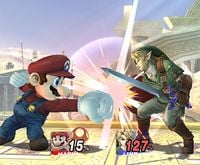Damage
Damage is the basic measure of how vulnerable a character is to the knockback of attacks. At low damages, the character cannot be knocked back very far, and can only be thrown off-stage by the game's most powerful attacks. However, at high damages, attacks deliver considerably more knockback, increasing the risks of severely damaged characters to be KO'd.
Damage is represented by a numerical percentage that starts at 0% and can rise all the way up to 999%. Despite this formatting, getting to 100% does not mean a character is doomed — the number itself is somewhat arbitrary. This value is displayed as an integer in every game prior to Ultimate, though is only actually measured as such in the original game. In Melee, Brawl, and Smash 4, it is actually a decimal value that is shown as a truncated integer. In Ultimate, the value is displayed to one decimal place (with the damage cap rendered as 999.0%).
Each attack deals a set amount of damage, which is then modified by things such as stale-move negation before the target is launched. An attack that does no damage will not cause targets to flinch and not produce a regular hit sound, although it will still cause knockback. The damage an attack deals is a significant factor in how much knockback it causes.
The following aspects are affected by damage:
- Knockback – As a character gets more damage, they fly further when hit. Certain attacks have set knockback, and don't apply damage to the knockback formula.
- Grab time – Characters at high damage can be grabbed for longer periods of time.
- Status time – Generally, characters with higher damage are vulnerable for longer from a status effect (such as sleeping). The exception is being stunned through a shield break – the more damage a stunned character has, the faster they can recover.
- Ledge recovery – Before Smash 4, a character's ledge animations change at 100% or more, becoming more sluggish and providing more invincibility frames. The slower attack also deals more damage (in all games this applies to, Captain Falcon's is the sole exception).
- Magnifying-Glass Damage – Characters will not accumulate hoop damage at 150% damage or higher.
- Jet Hammer & Hammer Flip – Like Magnifying-Glass Damage, King Dedede/Kirby will not be damaged by charging their attack when they have 150%
 /100%
/100%
 or more damage.
or more damage. - Lucario's attack power – The more damage Lucario has, the more damage its aura-based attacks do. In Brawl, the power is at its base level when Lucario is at 75%, while it stops decreasing at 20% and caps at 170%.
- Pikmin latch time – Pikmin release a character faster at higher damages.
- Certain recovery items:
- The Fairy Bottle's behavior – it heals a character only if they have 100% or more damage; otherwise, it acts as a Throwable item.
- A Team Healer's healing power – The more damage the target has, the more damage the item heals.
- Swim time – Highly-damaged characters have less time to swim before panicking, with characters at 96% or higher damage having the shortest swim time.
- Donkey Kong's forward throw – The more damage the grabbed character has, the longer they can be carried, similar to the grab time function.
- Instant KOs – Many potential Instant KOs, such as Danger Zones, Giga Bowser Punch, Infernal Climax, Plasma Scream, Triforce of Wisdom, All-Out Attack, Whack, Thwack, Sealing the Keyhole, and Death's Scythe, will fail to obliterate a character with less than a certain amount of damage and instead cause damage and knockback.
In lieu of sudden death, damage is used as a tiebreaker in competitive environments when players have equal stock remaining. The player with the least damage is considered the winner.
Trivia[edit]
- The most damaging single-hit move (excluding counters) is the strongest bite of the Ultimate Chimera in Brawl, inflicting 200% in a single hit.
- Considering multi-hitting moves, Lugia's Aeroblast in Melee can deal up to 440% in a little more than 2 seconds if all hits connect.
- While Ultimate was the first in the series to display decimal percentages on-screen, decimal points have actually been used in every Smash game since Melee. Up until Smash 4, the game would truncate that value to an integer and display that number on-screen.
- This caused a side effect where attacks seemingly had inconsistent damage output in certain circumstances because the hidden decimal would roll up to the next integer, which would be reflected on-screen.
- Another side effect was that players would occasionally be forced to go into Sudden Death because they have the same integer percentage on-screen when time runs out despite technically having a difference of less than 1% in the background.
See also[edit]
- HP – The measure of damage in Stamina Mode, which is also used by bosses.
